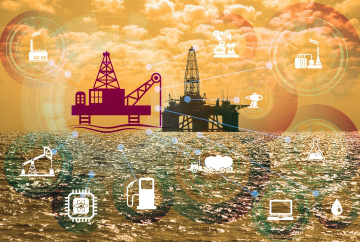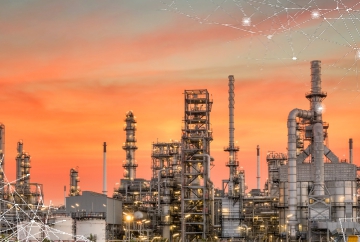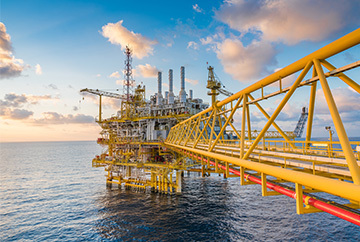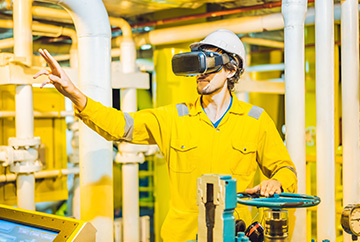Real-time Monitoring
An interesting article in
MIT Sloan Management Review, states "Supported by an estimated 25 billion connected global sensors by 2021, digital twins will soon exist for millions of things. A jet engine, a human heart, even an entire city can all have a digital twin that mirrors the same physical and biological properties as the real thing."
This implies that digital twins will result in much more precise and real-time assessments than what is possible today. Oil & gas companies, through digital twins, will be able to perform equipment repair literally 'in the moment.' Revolutionary, isn't it! Real-time data aids in monitoring the condition of oil & gas assets for predictive maintenance, which eventually helps optimize operational performance or manage alarming situations.
Digital Twin Use Cases in Oil & Gas Industry
Drilling Process Planning Using Digital Twin
The digital twin has a vital role to play in advanced and complex drilling operations. For
drilling rigs, digital twin assists drilling contractors to watch out for potential problems and enhance the efficiency of equipment maintenance. It also potentially reduces well construction time and unnecessary cost while augmenting the supply chain of scheduling rig moves, well services, etc.
The digital twin also paves the way for sustainable horizons in well construction by greatly reducing overall drilling time; encouraging and bringing confidence to contactless advisory and collaboration, and potential application in geothermal drilling activities.
Oil Field Performance Monitoring using Digital Twins
The digital twin significantly enhances a plant's productivity and quality parameters, which can especially be a boon for oil & gas plants. The digital twins help companies analyze if the plant is operating at its optimum or not. Additionally, it helps identify equipment issues that can result in unplanned downtime or correct process deviations before they result in quality slippage, scrap, and rework.
A Digital twin also boosts benefits which are achieved by six sigma programs and aids in continuous improvement. For instance,
Echo has been developed by Equinor to enhance safety and efficiency in project development and operations across its business areas. Echo allows the field worker to bring the "office" with them to the worksite.
Data Simulation And Analytics In a Digital Twin Strategy For Oil Field Production
Simulations of production facilities have the potential to assist the operators in arriving at the ideal operational workflows. An integrated part of a digital twin, data simulations & analytics examines the current data flows and promptly offer workable alternatives to help the system operators reach a decision when problems arise.
Straight from a Hollywood flick, digital twins augments run-the-simulation analysis, recognizing a possible scenario within the digital environment. With additional software and data analytics, digital twins optimize IoT deployment for maximum efficiency and help designers figure out where things should go or how they operate before they are physically deployed.
How is Digital Twin Technology Transforming the Oil & Gas Industry
Click to zoom in
Improving Safety of Workforce and Field Personnel
The digital twin has many facets when it comes to ensuring employees' safety. Companies are better positioned to monitor various potential exposures through the digital twin concept, such as weights being lifted, fatigue prediction exposures, radiation exposure, and accordingly develop instantaneous mitigation actions. In order to track critical biometrics data and used machine learning, a
US-based company deployed digital twins with a particular emphasis on fatigue prediction.
This operation works 24*7 and involves high-risk elements such as large earth-moving equipment, ledges without safety rails, and factors contributing to hazardous incidents. This has helped the companies detect early fatigue scenarios and corresponding equipment emergency shutdowns in critical fatigue situations.
Production Optimization
Companies are implementing digital twins, which empower them to make informed decisions and offer a digital vision for productive workflows. The
five stages that help companies in the digital twin journey include Organize/execute (CMMS – computerized maintenance management system); Improve (asset reliability); Manage configuration (IM – information management); Optimize (operational insights); and Visualize & maintain information (evergreen digital twin).
As part of the digital augmentation journey,
BP has augmented 30,000 barrels of additional oil & gas production a day during 2017. Its APEX production optimization tool makes use of integrated asset models. Additionally, it is also a formidable surveillance tool used in the field to spot issues before they have significant effects on production.
Asset Management
An
intelligent asset inspection program is imperative for gaining the upper hand in today's competitive environment. The operational status of a modern asset gets input from multiple data sources, including aerial surveillance data, sub-surface surveillance data, remote sensing, SCADA, and other sources like manual or visual inspections, requiring integration between the OT and back-office IT.
Once the data is captured, it is analyzed to determine how physical assets perform both in real-time and under various conditions for what-if scenarios. Specially crucial for oil & gas companies, the business process for engineering changes needs to encompass the digital twin in their asset management process.
Predictive Maintenance
The emergence of
IoT & Digital Twins has allowed businesses to build a predictive maintenance model that optimizes the maintenance cycle and strikes a perfect balance between a corrective and preventative maintenance approach. What does predictive maintenance do? It uses just-in-time replacement of components, which not only replaces those components that are close to a failure but also extends component lifetime by reducing unscheduled maintenance and labor costs.
Such an approach helps businesses achieve cost savings and competitive advantages. A case in point is the global oil & gas major
ADNOC, which uses continuous online monitoring, aided by machine learning analytics and digital twin models, which helps operators and maintenance personnel identify impending machinery issues earlier and shift from reactive to predictive maintenance.
How to Build Your Digital Twin Roadmap
To build a
Digital Twin roadmap for their plant operations, companies require description tags and data, such as geometry, layout, connectivity of critical components, and process data. This data and information are then shared across departments throughout its asset and operations lifecycles – from engineering, procurement, construction, commission, and operations.
Once all these are in place, the digital copy is updated in real-time, allowing performance monitoring of operations, such as well integrity, gathering systems, processes, or facilities. The same information can then be fed into analytics to model process behaviors and optimize operations from wells to processing facilities, improving productivity while reducing operating costs.
According to a
Gartner study, "with an estimated 21 billion connected sensors and endpoints by 2020, digital twins will exist for billions of things in the near future." Digital twins provide a real-time look at what's happening with physical assets, which will drastically reduce maintenance burdens.




